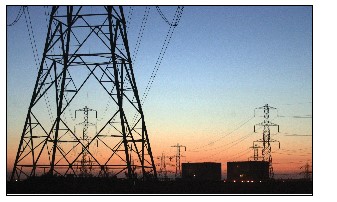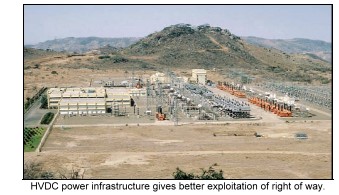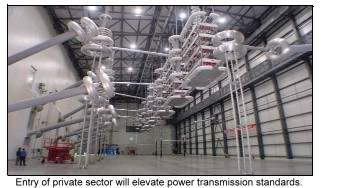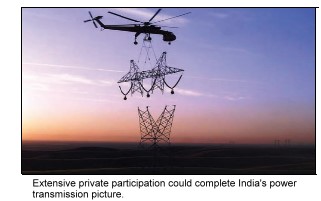
The recent advent of private
sector participation in power
transmission has been a
significant milestone for the
power sector. After cross-border
and inter-regional lines, private
sector entities are now seriously
looking at opportunities in intrastate
power transmission
infrastructure. This special report
by
Venugopal Pillai takes us
closer to recent developments in
states that have taken the lead in
ushering private investment in
the power transmission sector.
The advent of intra-state power transmission lines with
private sector participation is a key development in
India's pursuit of galvanizing private enterprise in the
power sector. Private participation in power transmission
started with the Indo-Bhutan power transmission line that
came up as a joint venture between Tata Power and Power Grid
Corporation of India in 2006. This made way for joint ventures
with PGCIL for inter-regional lines, followed by tariff-based
bidding for mega transmission lines. As far as intra-state lines
are concerned, the phenomenon is relatively new and is limited
to few states. According to information gathered by Electrical
Monitor, PPP in state-level projects has so far been observed in
four states-Maharashtra, Haryana, Rajasthan and Uttar
Pradesh. The following is a brief individual account.
Maharashtra: In April 2008, Maharashtra State Electricity
Transmission Company Ltd (Mahatransco) entered into a
minority joint venture partnership with JSW Energy Ltd to
develop transmission infrastructure for evacuation of power
from upcoming power plants in the Ratnagiri district. JSW's
4x300-mw Jaigad power project is also a beneficiary of this
project. This joint venture Jaigad Power Transco Ltd is widely
believed to the first instance of PPP in intra-state power
transmission in the country. The 400kV transmission system
comprising of the Jaigad-New Koyna line (55 km) and Jaigad-
Karad line (110 km) along with other infrastructure, was fully
completed this year.
In October last year, Mahatransco also entered into an
agreement with Adani Power to form a similar joint venture
for power evacuation from upcoming power plants in northeastern
Maharashtra including Adani Power's own 3,300 mw
Tiroda supercritical power project in the region. Accordingly,
Maharashtra Eastern Grid Transmission Company Ltd, a 74:26
JV between Adani and Mahatransco was formed. The
transmission network, estimated to cost

4,379 crore, will
involve two 765kV single circuit Tiroda-Koradi-Akola-
Aurangabad lines and 765kV/400kV substations at Tiroda,
Koradi, Akola and Aurangabad. It would also entail the
installation of 500MVA auto transformers and 765kV, 80
MVAR shunt reactors. The transmission lines will pass
through the districts of Gondia, Bhandara, Nagpur, Wardha,
Amravati, Buldhana, Jalna and Aurangabad. The project is
under construction and is scheduled to commission by 2013.
Speaking about future plans in PPP-based intra-state power
transmission projects, Mahatransco officials told Electrical
Monitor that the state utility has created a shelf of projects
that are under various stages of discussion. Mahatransco will
take a call on whether they could be implemented by the JV
route or the tariff-based competitive bidding route.
Transmission systems associated with two of Indiabulls
Group's projects— Sinnar (1,320 mw) and Amravati (1,320
mw)— are cases in point.
Private participation in intra-state power transmission |
| Company/SPV |
Ownership |
Private equity (%) |
Mode |
State |
kV |
Cost ( crore) crore) |
| Jaigad Power Transco Ltd |
JSW Energy* |
74 |
JV |
MAH |
400 |
488 |
| Maharashtra Eastern Grid Transmission Co Ltd |
Adani Power* |
74 |
JV |
MAH |
765 |
4,379 |
| Jhajjar KT Transco |
KPTL+Techno** |
100 |
DBFOT |
HAR |
400 |
450 |
| Maru Transmission Service Co Ltd |
GMR Energy |
100 |
BOOM |
RAJ |
400 |
200 |
| Aravali Transmission Service Co Ltd |
GMR Energ |
100 |
BOOM |
RAJ |
400 |
| Shekhawati Transmission Service Co Ltd |
Emco |
100 |
BOOM |
RAJ |
400 |
--- |
| South East UP Power Transmission Co Ltd |
Isolux Corsan |
100 |
BOOM |
UP |
765 |
870 |
| Western UP Power Transmission Co Ltd |
Cobra+MEIL*** |
100 |
BOOM |
UP |
765 |
875 |
| *Mahatransco holds 26 per cent **Kalpataru Power Transmission Ltd + Techno Electric Engineering Ltd |
| ***Cobra Instalactiones y Servicios SA + Megha Engineering India Ltd |
| Note: Compilation reflects projects awarded up to August 19, 2011, and may not be exhaustive |
Officials also indicated that private sector participation will
be critical to build new power transmission infrastructure in
Maharashtra. Currently, over 11,000 mw of new power
generation capacity is in the making, with over half of this
coming through private sector plants. These projects are in farflung
areas and would necessitate the creation of new and
more efficient transmission infrastructure.

Mahatransco officials also alluded to the fact that preproject
work involved in the structuring PPP-based
projects could be time consuming as it involves
concurrence of various agencies. However, the objective is
to begin construction work as early as possible.
Illustrating this point, officials explained that even whilst
there are some pending issues related to the formation of
Maharashtra Eastern Grid Transmission Company Ltd
(the joint venture with Adani Group discussed above), construction work on the project has begun. "In projects
of large magnitude, things have to move in parallel," an
official summarized.
Haryana: This northern state takes the credit for
structuring India's first intra-state power transmission line on
DBFOT basis. Last year, it awarded a

382-crore transmission
line using this mode to a consortium of Kalpataru Power
Transmission Ltd and Techno Electric Engineering Company
Ltd. The 400kV transmission system will help evacuation of
power from CLP India's under-construction 2x660-mw Jhajjar
supercritical power plant in Haryana.
Speaking to Electrical Monitor, a senior official of nodal
agency Haryana Vidyut Prasaran Nigam Ltd said that this
mode was chosen so as to avail financial assistance under the
Centre's viability gap funding (VGF) mechanism. The official
also noted that while Haryana has plans to develop more
transmission lines using the PPP mode, there were currently no
projects ready for bidding at the moment.
Dwelling on the current status of the Jhajjar transmission
system, the official said that construction work was going in
full swing on both the substation and transmission line
components. The project involves two 400kV double-circuit
lines—Jharli to Kabulpur (65 km) and Kabulpur to Dibalpur
(34 km) and two 440/220kV substations at Kabulpur and
Dipalpur respectively. The official noted that the substations
should be ready by October this year, while the transmission
lines should be completed by December. The targeted date for
commissioning of the project is January 2, 2012, he noted.
The Kalpataru-Techno consortium had won the project by
quoting a (positive) grant of

93.90 crore payable by HVPNL,
the grantor of concession. The project is being implemented
through a special purpose vehicle Jhajjar KT Transco Ltd. The
SPV received transmission licence from state regulator
Haryana Electricity Regulatory Commission in October 2010
and also attained financial closure shortly thereafter.

Power from this project will be purchased by Uttar
Haryana Bijli Vitaran Nigam Ltd (UHBVNL) and Dakshin
Haryana Bijli Vitaran Nigam Ltd (DHBVNL) for which
Haryana Power Purchase Centre (HPPC), the nodal agency
for both the power distribution utilities, has signed a power
purchase agreement with CLP India. For the purpose of
power evacuation, HVPNL invited bids for the construction
of the 400kV Jhajjar transmission line and associated
substations, on DBFOT basis under the PPP mode. HVPNL
initiated the bidding process in January 2009.
Private transmission players* |
| Entity |
Project |
| Tata Power Company Ltd |
CB |
| Reliance (ADAG) Group |
IR |
| Sterlite Technologies (Sterlite Grid) |
IR |
| Patel Engineering |
IR |
| BS Transcomm |
IR |
| Simplex Infrastructures Ltd |
IR |
| JSW Energy Ltd |
IS |
| Adani Power |
IS |
| Kalpataru Power Transmission |
IS |
| Techo Electric Engineering |
IS |
| GMR Energy |
IS |
| Emco Ltd |
IS |
| Insolux Corsan (Spain) |
IS |
| Cobra Instalaciones (Spain) |
IS |
| Megha Engineering Infrastructure |
IS |
| *Across all forms--JV, BOOM and DBFOT |
| CB=Cross Border, IR = Inter-regional, IS=Intra-State |
Rajasthan: Rajasthan has the distinction of having bid out
the maximum number of intra-state power transmission
projects using the tariff-based competitive bidding route.
According to information with Electrical Monitor, the
northern state has finalized three projects and is on the verge
of tying up another two. Rajasthan is also the first state to
have deployed the tariff-based competitive bidding route for
seeking private sector participation in developing power
transmission infrastructure.
Speaking to Electrical Monitor, a nodal officer of Rajasthan
Rajya Vidyut Prasaran Nigam Ltd said that by mid-September
2011, the developer for the 400kV Jhunjhunu-Jaipur (North)
Line is expected to be finalized. The response to the bidding has
been encouraging, he noted, without naming the bidders in the
fray. The selected developer will build the line and associated
substations, and operate it under the BOOM model. RRVPNL
has already formed a shell company Pink City Transmission
Ltd that will be transferred to the selected developer.
Officials of the Rajasthan state utility also indicated that
work has begun on selecting a developer using the same
BOOM model for a 400kV transmission system involving a
new line between Jodhpur and Udaipur, a 400/220kV
substation at Udaipur and associated works. This would be
fourth BOOM project for RVPNL.
Very recently, Mumbai-based Emco Ltd was selected as the
developer for a new Sikar-Nawalgarh-Jhunjhunu line with a
substation at Nawalgarh. The project, the fifth BOOM
venture of RVPNL, will involve 60km of single circuit lines at
220kV voltage, RRVPNL officials said. Subject to
completion of formalities, Emco will be handed over the
ownership of the shell company Shekhawati Transmission
Service Ltd. The shell company will act as the transmission
service provider. This project, it is learnt, marks Emco's
entry in the power transmission segment as a developer.
Emco is amongst the leading producer of transformers and a
wide range of T&D equipment.
Meanwhile, GMR Energy expects to soon start physical
construction work on two power transmission projects in
Rajasthan that it had won in November last year under the tariff-based competitive bidding route. In an interaction with
Electrical Monitor, Raaj Kumar, CEO - Energy, GMR Group, said
that all development (pre-project) work including securing of
clearances is complete and physical construction was expected
to start in September. Regarding the transmission licence, Raaj
Kumar noted that the public hearing for both the projects is
complete and Rajasthan Electricity Regulatory Commission is
expected to issue the licences soon. GMR Energy has taken
over two special purpose vehicles formed by RVVNL - Maru
Transmission Service Ltd and Aravali Transmission Service Ltd
- that will act as transmission service providers. While Maru
will develop the 400kV Bikaner-Deedwana-Ajmer line running
255 km, Aravali will be entrusted with the 150-km 400kV
Hinduan-Alwar line. Both lines will also involve substations
and associated infrastructure. GMR Energy is expected to
invest

200 crore in the two projects that also mark the group's
entry in the power transmission sector.
Uttar Pradesh: Uttar Pradesh has taken a big leap in
attracting private investment in the power transmission
sector. The northern populous state has finalized two large
transmission schemes that will be developed with private
investment, under the BOOM model. Speaking to Electrical
Monitor from Lucknow, a senior official of Uttar Pradesh Power
Transmission Company Ltd (UPPTCL) explained that while
one project has been awarded to Isolux Corsan, a Spanish
infrastructure-centric company, the other has been clinched
by a consortium of Cobra Instalaciones (also of Spain) and
Hyderabad-based Megha Engineering & Infrastructures Ltd.
"This is the first time that 765kV transmission lines will be
built in Uttar Pradesh, at the state level," the official
elaborated. The total investment in the two projects exceeds

1,900 crore.
The project awarded to Isolux Corsan involves developing
the 765kV single-circuit Mainpuri-Bara Line, an air insulated
switchgear (AIS) substation Mainpuri and associated works.
The project will have an estimated 1,600 km of high-voltage
transmission lines facilitating power transfer worth 4,600 mw
from upcoming generation plants in eastern Uttar Pradesh.
The concessionaire was selected through the competitive
tariff-based bidding route. UPPTCL has created a shell
company South East U.P. Power Transmission Company Ltd
that will be transferred to Isolux Corsan. The developer will
build and operate the project under a concession period of 37
years and six months.
PPP in power transmission is a win-win situation |
 — P.P. Gupta, Managing Director, Techno Electric Engineering Company Ltd — P.P. Gupta, Managing Director, Techno Electric Engineering Company Ltd
Techno Electric Engineering Ltd,
in consortium with Kalpataru
Power Transmission, has been
awarded an intra-state power
transmission line on DBFOT basis
in Haryana. P.P. Gupta discusses
the project and explains why
Haryana's model is worth
emulating by other states.
Tell us about the SPV formed
between Techno Electric
Engineering Co Ltd (Techno) and
Kalpataru.
The transmission project at
Jhajjar, Haryana is the first of its
kind PPP project in the country.
Techno Electric is working on the
project along with Kalpataru Power
Transmission Ltd (KPTL). The
project is being carried out by an
SPV, Jhajjar KT Transco Pvt Ltd in a
51:49 Joint Venture between
Kalpataru & Techno. It is the first
transmission project to get VGF
(viability gap funding) support
from the Centre. The total project
cost is  440 crore with Techno
putting in 440 crore with Techno
putting in  38 crore as equity. The
VGF provided by the central
government is 38 crore as equity. The
VGF provided by the central
government is  94 crore. 94 crore.
We understand that this marks
Techno's entry in the power
transmission business as a
developer.
Techno has a rich experience in the
power sector with more than three
decades of existence,
participating in more than 50 per
cent of the nation's power capacity
and national grid in one capacity or
the other. Techno recognized the
need for having an efficient
transmission infrastructure in the
country in view of growing demand
for power and the huge T&D losses
in the sector. Growing priority to
reduce transmission losses
through upgradation and building
new capacities made Techno enter
the transmission business in
2010.
What is the project scope?
Techno Electric in consortium with
KPTL has been awarded the project
to design, build, finance operate
and transfer (DBFOT) with a
concession period of 25 years
(extendable by 10 years) a 400kV,
100 km long power transmission
link, connecting two substations at
Rohtak and Sonepat in Haryana.
Techno will do EPC, operations
and maintenance work for the substation
part of the project.
What is the broad current status of
the project, and what is the
envisaged completion date?
This unique  440 crore project is
ongoing in a progressive way. IT
will be completed in a record time
of one year and is set to
commission by December 2011. 440 crore project is
ongoing in a progressive way. IT
will be completed in a record time
of one year and is set to
commission by December 2011.
Do you think, over the years, power
transmission will attract as much
enterprise and equity as power
generation is currently doing?
The Haryana Government
introduced a pioneering PPP
model with viability gap funding
for the establishment, operation
and management of a
transmission link, the first of its
kind in India. This business
segment is attractive from a
number of perspectives as it
entails design-build-financeoperate-
transfer rights resulting in
a wider revenue stream. The
Haryana government has been
engaged as a consultant by other
states wanting to replicate this
model.
We believe other states will also
follow the similar route of building
transmission network. The 18th
Electric Power Survey (EPS)
Committee chaired by the Central
Electricity Authority
recommended all-India T&D
losses to be brought down from
24.15 per cent to 17.09 per ent by
the end of the XII Plan and further
reduced to 14.17 per cent by the
end of the XIII Plan. To reduce the
losses we need to upgrade our
existing transmission network and
build new network. Building
network under PPP model is a winwin
situation for everyone and
would attract more enterprise and
equity going forward.
Please summarize Techno's future
plans in power transmission.
Techno plans to add one
transmission line to its portfolio
annually, resulting in a total of five
projects by the end of the XII Five-
Year plan. |
The project awarded to the consortium of Cobra and Megha
Engineering is equally significant. It will involve setting up of
the 765kV Mainpuri-Hapur and Mainpuri-Greater Noida Line
and two 765/400kV substations at Hapur and Greater Noida.
In all, the project will entail building of nearly 900 km of
transmission lines and at least six substations, with an
investment of over

800 crore.
The UPPTCL official said that the formal concession
agreements with the selected developers will be signed in the
coming weeks. The concessionaires are also expected to enter
into transmission service agreements with distribution
utilities of Uttar Pradesh, to whom power will be sold.
PRIVATE SECTOR OPTIMISTIC
Private sector participation in power transmission is slowly
making a beginning. What is inspiring is that private
participation has been noticed in all types of power
transmission projects—inter-regional, intra-state and even
cross border. An estimated fifteen entities, including
consortium partners, are currently involved in private
transmission infrastructure. At one end of the spectrum
there are large players like Reliance Power Transmission
(Reliance ADA Group) and Sterlite Technologies that are
singly implementing inter-regional schemes, and at the
other there are medium companies like Simplex
Engineering, BS Transcomm, Emco, Techno Engineering
and Kalpataru Power Transmission that have taken the
consortium route. Several PPP modes have been
harnessed—joint venture route, DBFOT and BOOM. It is
very clear that opportunities exist for all developers depending on their financial strength, execution
capabilities and risk appetite.
Private sector players are generally optimistic about their
power transmission forays; this was the overall reaction
conveyed by some transmission line developers that Electrical
Monitor got in touch with. These developers related to both
intra-state and inter-regional lines. According to Raaj Kumar,
CEO Energy, GMR Group, "Private participation in
transmission sector has started off well and outlook for greater
role in future is positive." GMR Group is implementing two
intra-state projects in Rajasthan on BOOM basis.

P.P. Gupta, Managing Director, Techno Electric Engineering
Ltd, is very encouraged by the DBFOT mode. In consortium
with Kalpataru Power Transmission, Techno is implementing
a power transmission line in Haryana structured on this mode.
In an interaction with Electrical Monitor, P.P. Gupta noted,
"Haryana has introduced a pioneering PPP model with viability
gap funding for the establishment, operation and
management of a transmission link, the first of its kind in
India. This business segment is attractive from a number of
perspectives as it entails design-build-finance-operate-transfer
rights resulting in a wider revenue stream." (See "PPP in power
transmission is a win-win situation"). Gupta also feels that
other states might be inspired to toe Haryana's line.
Rajesh Agarwal, Managing Director, BS Transcomm also
exuded optimism on private sector participation in power
transmission. He noted that the commitment of the Indian
government towards the role of private participation is
commendable and it is evident with the inclusion of private
sector players in tariff-based competitive bidding for interstate
transmission lines. Commenting on the need for private sector
participation, Agarwal noted, "The ambitious plans of the
government of adding 1,00,000 mw of power generation
capacity during the XII Plan needs adequate transmission
infrastructure and private sector can play a pivotal role
towards establishing a power evacuation infrastructure. A
number of transmission projects in different regions have
earlier been awarded to successful private bidders and the
further development of new projects leveraging the strength of
private sector will help in strengthening power transmission system in the country and introduce competitiveness in this
sector benefiting the end user."
The government could do well to assist the private sector,
Agarwal noted, explaining, "Inclusion of transmission
business under special infrastructure similar to roads, ports
could pave way for addressing challenges such as right of way
and offer long term financing methods, ensuring better returns
on equity for private developers."
Sterilte Technologies Ltd, the world's largest manufacturer
of power conductors, is now emerging as a leading power
transmission developer with three inter-regional lines
including some with 765kV technology. Pravin Agarwal,
Whole-time Director, Sterlite Technologies Ltd, is also upbeat
on the prospects of intra-state line. Agarwal notes, "Given the
huge transmission capacity which is required to be built over
the next 5-7 years, intra state grid strengthening would assume
the same importance as inter state grid strengthening. We
believe that intra state projects do not suffer any drawbacks as
compared to inter-regional projects. The state governments
need to be more proactive in identifying and putting up more
transmission projects for competitive bidding."
EPILOGUE
Looking at PPP in intra-state transmission lines so far, one can
only say that a beginning has been made. The overall progress
seems highly incommensurate with the potential. To be best of
Electrical Monitor's knowledge, only four states - Maharashtra,
Haryana, Rajasthan and Uttar Pradesh - have made tangible
progress. The list should have been bigger considering that
several progressive states are nowhere close to even making a
beginning. As would be case in any PPP project, there is never a
dearth of private capital or enterprise. It is the ability of the
government to create a shelf of bankable and profitable
projects, and quickly move towards the bidding process. In this
context, the progress recorded by these four states reflects
their proactive attitude; it is not only about fulfilling
inadequacy in power transmission infrastructure.
The need for private sector participation in power
transmission cannot be overstated. There is tremendous
opportunity at all levels -- inter-regional lines, intra-state lines
and even cross-border lines. Over the past decade, private
sector has done well in terms of setting up power generation
capacity. Going forward, an increasing proportion of India's
new power plants are expected from the private sector. The
same culture must permeate to power transmission; the
sooner the better.
Despite there being only six-odd PPP projects so far awarded
for intra-state projects, there is an interesting observation—
the advent of foreign investment. Isolux and Cobra, both
Spanish infrastructure companies, have bagged two large
power transmission schemes in Uttar Pradesh. That power
transmission, even in its early years of privatization, is finding
favour amongst international investors is a positive augury.
Private participation can bring much needed technological
advancements. Left to themselves, state transmission utilities
would prefer scaling up technology in degrees. However,
private players would tend to adopt advanced technology— as
it is linked to their financial returns from the project—from
the very outset. A case in point is EHV lines. Maharashtra and
Uttar Pradesh will see the deployment of energy-efficient
765kV lines in some PPP projects awarded. This is a major
achievement given that the highest voltage seen in stateowned
transmission lines thus far is 400kV.
The existing policy framework and guidelines on PPP allows
for several models for state transmission utilities to choose
from. States can go for the joint venture route, DBFOT model
or even the tariff-based competitive bidding route. State
transmission utilities need to be innovative in structuring their
projects using the optimum PPP model.
As inter-regional lines get build, intra-state power
transmission will need to match pace. State power
transmission utilities will need to take a very proactive role in
involving significant private sector participation. Sooner or
later, private sector role will have to emerge in intra-state
power transmission. State government transmission utilities
will benefit from proactive measures like taking on the role of
a nodal agency to identify, structure and bid out projects.
Tariff-based bidding seems to be the way forward. Effective
January 5 this year, the power ministry has mandated that all
inter-regional power transmission lines will have to be
awarded on tariff-based bidding route. This philosophy should
trickle down to intra-state lines in future. If state transmission
utilities initiate the PPP culture—even while it is not
mandatory as of now—the movement to tariff-based bidding
would be easier. It is also believed that tariff-based bidding can
contribute to bringing down power transmission costs.
Utilities have so far used the "cost plus" method, which
generally means that transmission tariffs are worked out as a
"mark up" over the transmission line cost. Hence any cost
escalation would be reflected in the power tariffs. In the tariffbased
bidding mode, the tariffs are decided upfront, and are
hence insulated from vagaries of project cost escalations.
Private sector participation in intra-state power
transmission lines is definitely the way forward. How rapidly
one moves into this regime depends directly on how proactive
and how involved state power transmission utilities choose to
be in ushering the new regime.